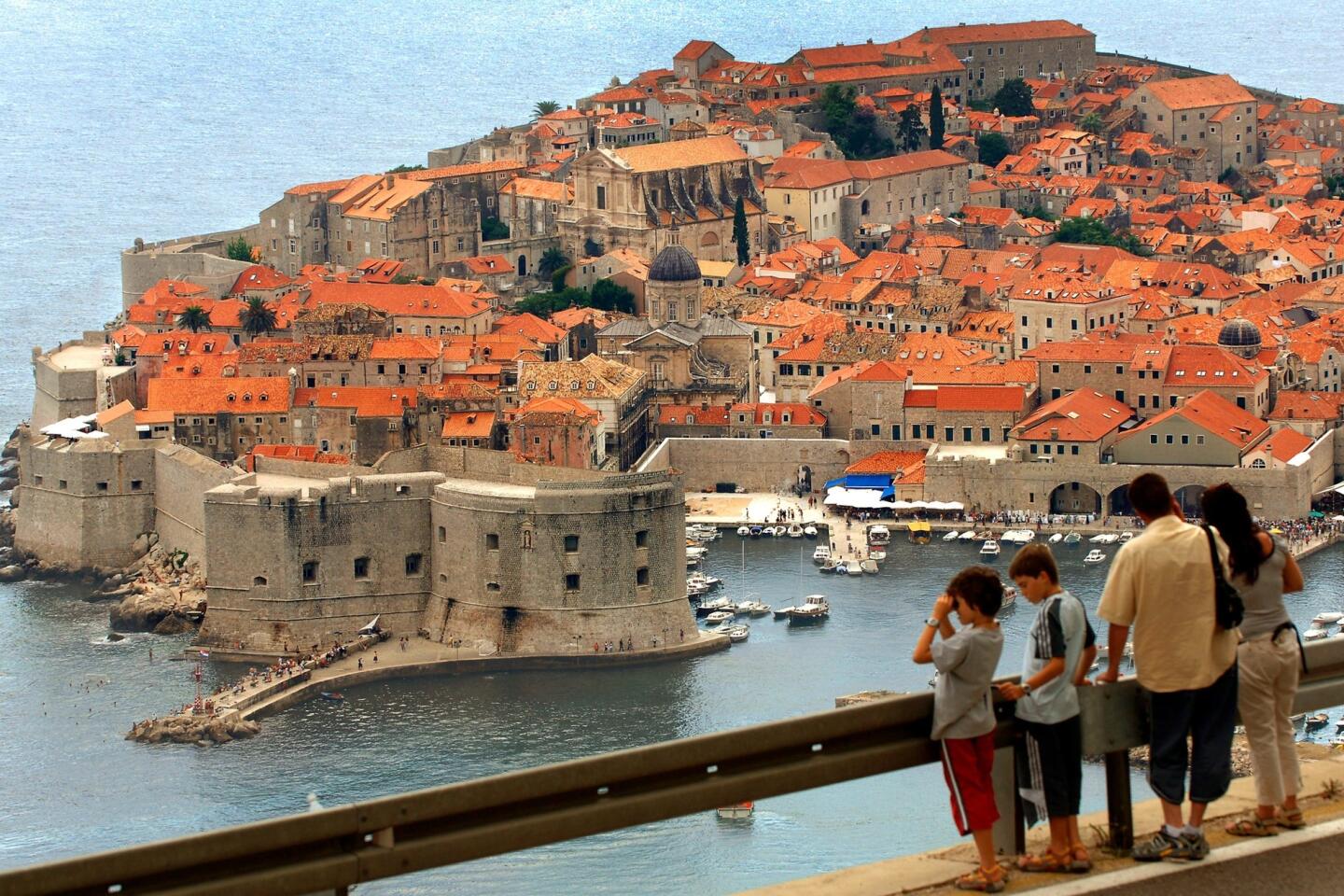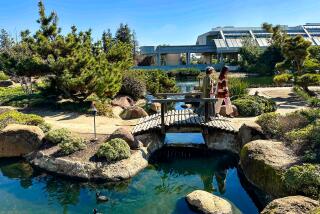Croatia, where water park meets World Heritage Site
Some years ago, in the early days of our getting to know each other, my boyfriend told me about one of his most memorable meals, at a restaurant on a rock ledge overlooking the Croatian Adriatic. He had been covering the Bosnian war and had escaped to the coast, just for a day, with a few colleagues.
They lingered over a meal of fish and a few bottles of wine, watching twilight descend like a pink veil over the water, a brief pause from the fallout over the breakup of the former Yugoslavia. The evening’s calm beauty had stayed with him, and he knew he would return to this unsung sliver of the Adriatic.
Nearly two decades have passed since the 1995 Dayton accords officially ended the bloody four-year war. Croatia, once an untrodden gem (at least by U.S. standards), is now the fastest-growing tourist destination in the Mediterranean region.
Despite this reality, the lovely image rendered for me years earlier of a place less traveled had not faded. In June, our family decided to discover whether the hot spot had retained its allure. We focused mainly on the lower Dalmatian Coast, eager to immerse ourselves in the stretch from Split in the north to Dubrovnik in the south.
We flew into Venice, Italy, a city we loved and that provided a mission for our 9-year-old daughter: to see how many canal bridges she could cross without repeating any. Three brilliantly sunny days and 84 bridges later, we drove from Italy to Plitvice Lakes National Park, our first destination in Croatia.
We had not initially included Plitvice in our plans, but in reading about Croatia’s wonders beyond the famous shoreline, we decided not to overlook this lauded park. As we drove, the country’s splendors quietly unfolded before us, with miles and miles of pine-covered mountains flanking the highways, vast meadows, bucolic country lanes and verdant hillsides sprouting Alpine-style houses.
Exploring Plitvice the next morning rewarded us with a veritable water world. The park is a UNESCO World Heritage Site, a deserved designation. Its 12,000 acres of rich, variegated greens, punctuated by 16 turquoise lakes, crystalline streams and dozens of waterfalls, provided an ethereal backdrop as we walked along miles of wood-plank paths. Alas, no swimming allowed, but the temptation was huge, especially when we grabbed a rare moment of solitude apart from the other tourists gazing at all that liquid beauty.
That evening at dinner, thinking about the natural bounty that had surrounded us at the park, we agreed that the Plitvice detour had been worth it.
Fueling up the next morning with one of many excellent cappuccinos we ordered at cafes or rest stops along the way (Italy has some serious competition from Croatia when it comes to a well-executed espresso or cappuccino), we took off for our next stop, the much-heralded city of Dubrovnik, yet another Croatian contribution to the list of UNESCO World Heritage Sites.
Many hours later, cruising along narrow roads that offered vertigo-inducing — and dreamy — views of the coast, we reached our hotel, a Radisson Blu resort on the outskirts of the city.
The modern hotel appeared out of place with the surrounding Mediterranean landscape and architecture, but the view from our spacious room and a baptismal dip in the clear Adriatic erased all judgment about the resort.
The water was a touch chillier than expected, but we quickly acclimated and over the next few days spent hours floating in the sea, skipping stones or swimming to an outcropping of rocks that begged to be used as a platform for jumping.
Other resort offerings, such as a rock-climbing wall, kids’ center and the requisite spa upped the wow factor, as did two inviting pools dramatically perched above the pebble beach. This was an easy place to be lulled into a vacation state of mind.
Not so relaxing was the spectacular but overcrowded, over-commercialized Old Town of Dubrovnik, where we were greeted by buses unloading a profusion of tourists and vendors hawking a variety of water and land activities.
Once inside the pedestrian-only town, a contained maze of stone alleyways and stairs packed with cafes, low- and high-end shops, galleries and apartments, we made a beeline for a pathway that seemed to float along the top of the City Wall.
Here, with one movie-ready vista after another, we enjoyed the tableau of red-roofed houses rising above the smooth blue sea. We saw vestiges of the Croatian War of Independence (as it is called here) in the 1990s, mostly in the form of crumbling, bombed-out or fire-damaged buildings; a small but high-impact museum commemorating Dubrovnik’s fallen soldiers is within Old Town’s stately wall.
Later, at a harborside restaurant, we ordered fresh local fish and octopus accompanied by a salad of arugula and olives, a classic Mediterranean repast, and lingered to watch the silent navigation of boats and ships at sunset, the chaotic day melting into a peaceful evening.
Our next stop, Split, is aptly named: It is a modern port city sharing valuable real estate with Roman ruins, the centerpiece of which is the well-preserved Diocletian’s Palace (also a UNESCO World Heritage Site). The vast structure, built by Roman emperor Diocletian between the late 3rd and early 4th centuries after abdicating his power, puts to rest any notion of scaling back in retirement. We wandered the snaking alleys and marveled at the improbable blend of ancient backdrop and trendy stores, restaurants and camera-wielding tourists.
We stopped at Split primarily to catch a two-hour ferry ride to the island of Hvar. We had wondered whether Hvar was a wise choice; for better or worse, it has become a hub for the glitterati. Indeed, it offers sophisticated hotels and eateries, along with the yachting crowd, in Hvar Town, the island’s largest town and main arena for the social set.
For the more nature-oriented, the reward of gorgeous (mostly pebbly) beaches and coves remains part of Hvar’s appeal. Opportunities to sail, kayak or swim abound — it’s a watery playground surrounding hills covered with lavender and pine and olive trees.
Our comfortable accommodations, one of two apartments in the bottom floor of a home, were across the street from the sea. A quick walk down the craggy white rocks that rim the island and a dive into the water satisfied our never-ending quest for liquid immersion.
We were not alone — no matter where we wandered on the island, by car or foot, people were in the water, some of them swimming far from any beach or jumping-off point. Where’s there’s water, there’s a way, so it seemed.
When we ventured farther afield, our gracious hosts, who lived in the upper apartment, provided us with great recommendations. We took leisurely walks into Hvar Town to purchase cheese, bread and the tastiest tomatoes I’ve ever had to enjoy on our patio.
A morning trek to the fortress, its commanding location above Hvar Town, offered unparalleled views of the harbor and the small Pakleni Islands beyond. Inside the stone walls, our daughter wondered about the tiny, water-view windows in the half-dozen or so claustrophobic jail cells — did they make life bearable for the prisoners or drive them insane with the desire to escape?
On our last evening, we had a seafood feast at the rooftop restaurant Luna in town, then gathered with locals and other visitors to listen to an orchestra playing classical music in St. Stephen’s Square. If the beautiful people had overtaken the town, we didn’t notice.
The northern town of Opatija was our last stop. After an early-morning return to the mainland from Hvar, we left the Dalmatian Coast and began the four-hour drive to the northeastern corner of the Istrian Peninsula. We wondered how Opatija would stack up against the southern points we had visited.
Our Hvar hostess had lived here years ago and told us to expect an atmosphere more reminiscent of Croatia’s communist past, when the country was still part of Yugoslavia. She assured us, though, that the setting was another example of Croatia’s coastal riches.
We quickly checked into our hotel, donned swimsuits and dashed to the water, where we swam with other families and zipped down a giant slide resting beside a cove.
That evening we strolled along the Lungomare, the ribbon-like promenade fronting the Adriatic, stealing a little more time to enjoy the soft summer air and pleasant hum of activity.
And our hostess’ take on Opatija? Some of the architecture, including our austere, block-like hotel, definitely recalled a certain 20th century communist style; in contrast, though, were pastel Victorian homes dotting steep green hillsides and grand seaside hotels with vistas stretching across the Kvarner Gulf, the enchanting scene straight out of a fairy tale.
Earlier in the trip, on the stone patio of a restaurant where the setting sun cast firelight over the water, I wondered how this scene would compare with my former boyfriend’s recollection. So I asked him.
“It’s just as I remember it,” my husband said, lifting his wine glass in a toast, all of us ready to dine on fish straight from the sea.
More to Read
Sign up for The Wild
We’ll help you find the best places to hike, bike and run, as well as the perfect silent spots for meditation and yoga.
You may occasionally receive promotional content from the Los Angeles Times.







